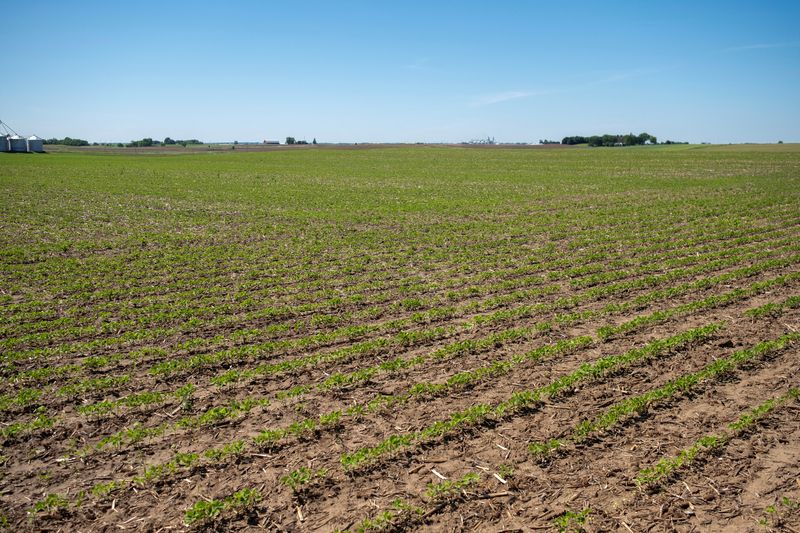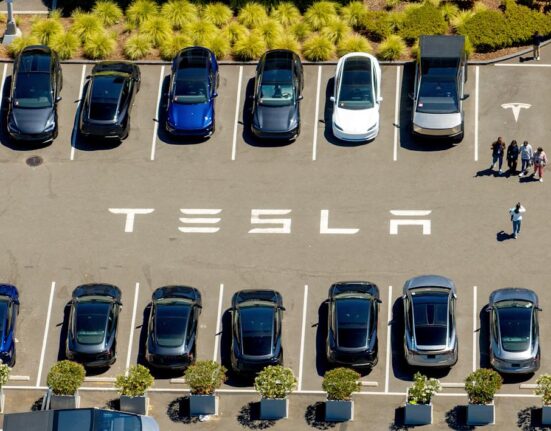By Tom Polansek
WATERMAN, Illinois (Reuters) -A trade mission to Nigeria. A memorandum of understanding with Vietnam. A surge of purchases from Bangladesh.
These countries are not typically major customers for soybeans from the U.S. farm belt. But desperate farmers, their trade organizations and President Donald Trump‘s administration are turning to far corners of the world in hopes of averting a disaster for agriculture from a trade war that has kept China from purchasing U.S. supplies.
The efforts so far are failing to offset the loss of the country’s biggest customer for the crop, data and interviews show, with financial pain extending to tractor makers and other agricultural businesses.
For the first time in more than 20 years, Chinese importers have not yet bought soybeans from the autumn U.S. harvest, forcing farmers to store their crops on hopes that prices will eventually rise from around a five-year low. It is a risk that delays their ability to bring in money from crop sales at a time when they face rising costs for everything from labor and energy to fertilizer.
In a sign that hard times are expected to continue in rural America, Trump has promised to give proceeds from tariff revenues to farmers, who largely supported his campaigns for president.
On Thursday, U.S. Treasury Secretary Scott Bessent said the government would make an announcement on Tuesday about support for farmers.
Tit-for-tat tariffs that Washington and Beijing imposed on each other’s goods this year have made U.S. soybeans too expensive for Chinese buyers, leading importers to buy from South America instead.
But alternative markets for U.S. exports are tiny by comparison and have not replaced China, long the world’s biggest importer by far.
CRISIS ACUTE FOR ILLINOIS SOYBEAN FARMERS The crisis is particularly acute in Illinois, the largest U.S. soybean producing and exporting state.
About 60 miles (97 km) west of Chicago, where the city and suburbs start to give way to green fields, farmer Ryan Frieders, 49, will be storing much of his beans in bins after previously selling some of his expected harvest at prices below the cost of production.
After months of work that included planting seeds, fertilizing fields and spraying weedkillers, Illinois growers are facing losses of up to $8 per acre thanks to low crop prices and weak exports, according to University of Illinois estimates.
U.S. soybean exports to China dropped 39% by volume to 5.9 million metric tons from January to July, before the autumn harvest began, the latest government data show. By value, shipments sank 51% to $2.5 billion, robbing farmers of billions of dollars’ worth of business.
By Tom Polansek
WATERMAN, Illinois (Reuters) -A trade mission to Nigeria. A memorandum of understanding with Vietnam. A surge of purchases from Bangladesh.
These countries are not typically major customers for soybeans from the U.S. farm belt. But desperate farmers, their trade organizations and President Donald Trump‘s administration are turning to far corners of the world in hopes of averting a disaster for agriculture from a trade war that has kept China from purchasing U.S. supplies.
The efforts so far are failing to offset the loss of the country’s biggest customer for the crop, data and interviews show, with financial pain extending to tractor makers and other agricultural businesses.
For the first time in more than 20 years, Chinese importers have not yet bought soybeans from the autumn U.S. harvest, forcing farmers to store their crops on hopes that prices will eventually rise from around a five-year low. It is a risk that delays their ability to bring in money from crop sales at a time when they face rising costs for everything from labor and energy to fertilizer.
In a sign that hard times are expected to continue in rural America, Trump has promised to give proceeds from tariff revenues to farmers, who largely supported his campaigns for president.
On Thursday, U.S. Treasury Secretary Scott Bessent said the government would make an announcement on Tuesday about support for farmers.
Tit-for-tat tariffs that Washington and Beijing imposed on each other’s goods this year have made U.S. soybeans too expensive for Chinese buyers, leading importers to buy from South America instead.
But alternative markets for U.S. exports are tiny by comparison and have not replaced China, long the world’s biggest importer by far.
CRISIS ACUTE FOR ILLINOIS SOYBEAN FARMERS The crisis is particularly acute in Illinois, the largest U.S. soybean producing and exporting state.
About 60 miles (97 km) west of Chicago, where the city and suburbs start to give way to green fields, farmer Ryan Frieders, 49, will be storing much of his beans in bins after previously selling some of his expected harvest at prices below the cost of production.
After months of work that included planting seeds, fertilizing fields and spraying weedkillers, Illinois growers are facing losses of up to $8 per acre thanks to low crop prices and weak exports, according to University of Illinois estimates.
U.S. soybean exports to China dropped 39% by volume to 5.9 million metric tons from January to July, before the autumn harvest began, the latest government data show. By value, shipments sank 51% to $2.5 billion, robbing farmers of billions of dollars’ worth of business.












Leave feedback about this